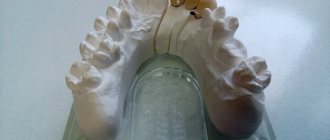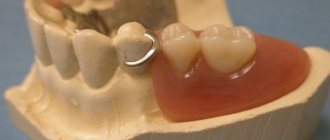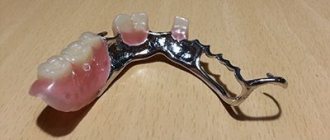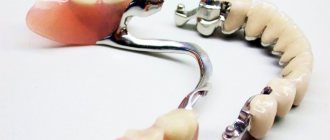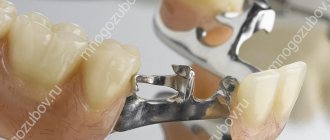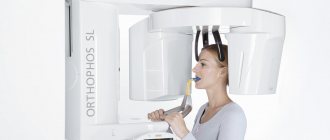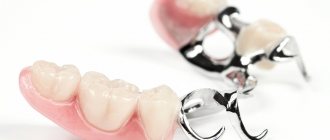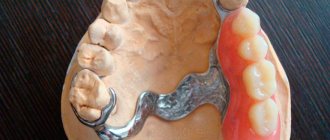A clasp denture is an ideal solution for restoring a number of teeth in the lower jaw, when the patient has retained several of his dental units, but it is not possible to install a full-fledged bridge on them for objective reasons. Also, this design is ideal if the patient does not want (or cannot) install implants, but wants to restore his smile and achieve optimal results for a reasonable budget. Yes, the clasp prosthesis for the lower jaw is a removable model, but it copes with the task perfectly, is a worthy alternative to outdated plate models, and the service life of such a solution is from 10 years.
Removable clasp prosthesis for the lower jaw - consider in detail
Why is a denture for teeth called clasp? The name itself comes from the word “arc”. It is based on a thin cast arc-shaped metal element, onto which a plastic base imitating gum is fixed, as well as artificial crowns - smooth and beautiful teeth. Thanks to the arch, the teeth replacement system is highly durable and reliable, because it will have to be removed and put on at least once a day. As a result, the patient receives a compact, lightweight, comfortable prosthesis for the lower jaw, which is easy to get used to in the first few hours after installation.
How is the prosthesis fixed on the supporting, pre-prepared teeth of the lower jaw? Using hooks or special elements. They are placed on top of the patient’s teeth or on pre-implanted implants. By the way, the prosthesis locks themselves are made not only of a metal alloy, but also of plastic, which is especially important for people with an allergic reaction to metal. But the gums can be made of either nylon or plastic bases (acri-free, quadrotti solutions). When it comes to dental crowns, they are usually made from a plastic material that imitates enamel.
It is important! The specificity of the prosthesis for the lower jaw presupposes that the arch is located on the side of the tongue, that is, where it is not visualized at all. The distance from the arch to the cervical area of the teeth is approximately one millimeter, and a little more is the distance to the bottom of the mouth.
Clasp design
Such support-retaining mechanisms, which are extensions from the base of the prosthesis, are most often made of metal. This allows you to chew food efficiently and painlessly. The upper clasp fastenings do not affect diction and do not dull the sensitivity of taste buds located on the palate. The design, despite its simple structure, copes with restoring the function of chewing food better than nylon or plastic counterparts.
Design with metal clasps
Due to the destructive effect of metal on enamel, it is recommended to first install abrasion-resistant crowns on the abutment teeth.
The outer part of the clasp is visible on the surface of the teeth, but if the aesthetics of a smile is important to the patient, then the front clasps can be made of invisible polymer materials.
Polymer clasps
Indications for prosthetics
Clasp dentures are installed on the lower jaw if:
- there is an extensive defect - for example, more than two teeth in a row are missing;
- all teeth are completely missing - in this case, to fix the prosthesis, the patient is first implanted with supporting implants;
- the last teeth in the row are missing;
- The patient has chronic periodontitis and there is a need to additionally strengthen the remaining teeth in the row with the help of a prosthesis.
In the meantime, prosthetics with clasp artificial structures are not recommended when:
- there are less than four teeth left in the jaw - unfortunately, this is not enough for a high-quality support base;
- the patient suffers from acute chronic illnesses;
- bone problems have been diagnosed (for example, osteomyelitis of the jaw, as well as osteoporosis);
- a person has an inflamed oral mucosa.
Clasp dentures - what is it?
In some cases, even professional treatment cannot help restore teeth, especially in advanced and complex cases. Quite often the patient seeks help very late.
Naturally, you can use other methods of prosthetics. For example, make classic plastic dentures or removable nylon dentures. But when choosing the right option for yourself, think about how comfortable you will feel and how long the denture will last for you.
And the third drawback is the role in the design of a huge number of teeth. This type of clasp prosthesis implies the constant protection of the supporting teeth with metal-ceramic crowns, since locking fasteners are placed on them. Clasp dentures with locks.
The process of getting used to the clasp prosthesis - features and nuances
The process of getting used to a clasp denture installed on the lower jaw is not at all quick. At first, the patient may be bothered by excessive salivation and discomfort while chewing food. There may also be speech defects - it is difficult for a person to pronounce hissing and whistling sounds. Also, at first you may feel a slight rubbing of the oral mucosa, but this is normal.
If discomfort when wearing dentures bothers you for more than a week, you need to visit a dentist. The system may need to be adjusted slightly to resolve the discomfort.
Reviews
Before choosing a design with any type of fixation, it is worth analyzing reviews of clasp dentures left by people who already use such designs.
- After retirement, I decided to get dentures. I was missing a lot of teeth, which I lost at different times, but since I haven’t liked dentists since childhood, I had to come to terms with being toothless. I really didn’t want to have false teeth, because from my grandmother’s experience, I understood that there was nothing good about it. I remember that every time my grandmother took off her false teeth before going to bed and put them in a glass of water for storage. In general, I really didn’t want my grandmother’s fate. My daughter forced me to see doctors to restore my lost teeth. The dentist recommended clasp dentures. Firstly, such a prosthesis does not need to be removed at night, and secondly, clasp dentures can be used to strengthen loose teeth and then you can still save what is left. As a result, my new teeth have nothing in common with my grandmother's dentures. They don’t bother me at all, they look aesthetically pleasing.
- After thirty-five years of age, due to periodontal disease, I began to gradually lose teeth. I didn’t go to the dentist because I was afraid to treat my teeth since my youth. When I realized that this couldn’t continue like this, I went to a dental clinic, where I was offered implantation. I refused implantation and preferred a clasp design with clasps, for which I am now paying. For me, some significant disadvantages of the prosthesis turned out to be: the design is not stable enough in the mouth, the hooks are visible when talking, as they fall into the smile zone. I am very dissatisfied with the prosthetics, but I try not to pay attention to these shortcomings.
- Before restoring my chewing teeth, I searched for information on the Internet for a very long time, consulted with dentists, and finally chose a clasp denture with a clasp type of fixation. I didn’t want to do bridge prosthetics at all, since installing a bridge requires preparing the supporting teeth and fixing additional crowns. I was very pleased with the result. Installation of the prosthesis is completely painless. The design is not visible at all, since the clasps are located at the back and are not visible when smiling.
- I installed a clasp prosthesis three months ago. After installation, I could not eat normally for a week; during a conversation, the prosthesis dangled in my mouth. I had to go to the dentist again. As a result, the doctor slightly adjusted the design, and the clasp sat straight, it was just necessary to eliminate the balancing of the structure. While getting used to the prosthesis, I experienced some inconvenience, but gradually everything fell into place. Now I use my new teeth as if they were my own.
- I urgently needed to restore several teeth on one side of my jaw. The doctor recommended a clasp denture with clasps. This design fits perfectly in the mouth, does not cause discomfort, and does not interfere with diction. After installation, I regretted that I had chosen this type of prosthesis, since it turned out that the hooks were located on the front surface of the tooth and everyone could see this defect. At first I tried to cover my mouth with my hand when talking, but now I’ve gotten used to it. This is the only drawback that doesn’t suit me, but it’s too late to change anything. I’ve been using the design for three years now, it’s very convenient, but the aesthetic drawback still remains a problem. Next time I will take a more serious approach to solving the issue of prosthetics.
How much does a clasp prosthesis cost?
The price of lower jaw prosthetics using a clasp design depends on the following factors:
- base and frame material;
- the number of teeth that need to be restored with a prosthesis;
- material for dental crowns.
The average price of a clasp prosthesis is from 32,000 rubles. The price, as a rule, already includes payment for the prosthesis itself, treatment planning, installation of the system, and check-ups with the dentist.
Clasp dentures are an inexpensive and accessible way to restore a smile with a long service life (more than 10 years).
On telescopic crowns
This method of prosthetics is very common abroad. The supporting teeth are ground down, then metal caps are attached to them using cement. Two crowns are placed on the prosthesis frame. When put on, they are inserted on top of the caps.
The design is invisible during a conversation, evenly distributes the chewing load and is well fixed. This is the most expensive design to install.
Stages of prosthesis manufacturing
Correction of the dentition with metal arches is only possible if the patient has supporting elements on both sides. Otherwise, it will be difficult to fix the system in the mouth. The process of making a bulgel takes from 1 to 3 weeks.
Before installing the product, the dentist notes all the structural features of the elements in the oral cavity and adjusts the structure to them. During the splinting process, the patient must visit the dental clinic several times
The prosthesis production process itself consists of several stages:
- Preparing the oral cavity for the procedure. The oral cavity is examined and the necessary parameters are calculated to select the optimal orthodontic design. The dentist cleans plaque from the supporting units and makes impressions for the lower jaw.
- Making casts from plaster or wax. The model is made in a three-dimensional projection, from which the specialist makes the frame of the future prosthesis.
- Fitting and fitting of the corrective system. After eliminating all the deficiencies, the specialist replaces the wax part of the system with a plastic or metal one.
- Installation of the device in the oral cavity, its grinding and polishing.
How to quickly get used to dentures
Simple recommendations will help you go through all 3 phases of addiction much faster. However, it should be remembered that the main thing is the psychological attitude. It will help you endure discomfort more easily and fight the temptation to remove the prosthesis. Visualizing a new smile, imagining changes in appearance and life, and thinking about what problems a new jaw will solve promote emotional and physical relaxation and accelerated adaptation. This is especially true for the upper jaw, because it is more difficult to get used to a denture with a palate. It takes up a lot of space, blocks the taste buds, and is very disturbing.
The following will help you get used to dentures faster:
- Diet
. In the first days after installation of the restoration, it is better to avoid solid foods. Porridge, puree soups, curds and yoghurts will help you survive the most difficult first days until chewing function is restored. - Slow chewing
. Be sure to involve both sides in the process to evenly distribute the load. - Adhesive preparations
. Creams and gels like Corega (Corega) help to better fix the jaw while the muscular system gets used to the restructuring. - Reduced physical stress
on the jaw. At first, it is better to cut food into pieces and avoid biting. - Conversations and reading aloud
. Diction after dental prosthetics will be restored faster if you talk a lot. The more you train, the faster the phonetic apparatus will adapt to the new state. You can slowly count to 100. Read prose and poetry, gradually increasing the pace. Talk with loved ones.
Dentists' advice: do not remove the structure at night during the adjustment period. This also promotes faster adaptation to dentures.
